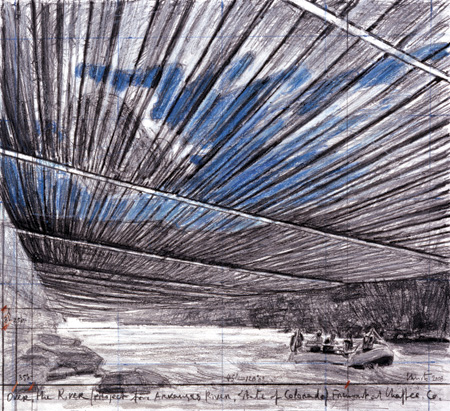
"Over the River," Project For The Arkansas River, State of Colorado
2008, Collage with pencil, enamel paint, wax crayon, 16" x 19"
Photo: Wolfgang Volz; Courtesy: the artist
For more than half a century, environmental artist Christo, in collaboration with his late wife Jeanne-Claude, has created non-objective interventions into the landscape and cityscape typically on an enormous scale that dwarfs even Mount Rushmore. The original ideas that form the underpinnings of their oeuvre are brilliant in the context of contemporary art, because their pieces are at once modern and postmodern. Astoundingly, they've pulled this off by embracing one of the most conservative branches of Western Art, the landscape tradition. But they've turned it upside down by using the scenery not as a subject but as a medium. So, instead of depicting the view, they convert it into just one of their mixed materials.
Over the decades, Christo and Jeanne-Claude have done things like wrapping enormous buildings, enveloping actual islands, and constructing a fence that was over twenty miles long. These outlandishly heroic projects, and many others of the sort, have made the couple and their work internationally famous. Their latest effort, which was in development long before Jeanne-Claude died in 2009, is called Over the River, and is planned for the Arkansas River in southern Colorado. If all the stars align, and, more importantly if all the necessary permits are approved, the piece will be completed in 2013 or '14.
The idea for Over the River calls for the construction of canopies that will extend over intermittent parts of the Arkansas along a 42-mile stretch between the towns of Salida and Canon City. These canopies, which will stretch from side to side, will use six miles worth of synthetic fabric. Cables will be anchored into the rocky banks on either side of the river to hold up the armatures for the fabric; they will be installed so that viewers--and kayakers--will be able to pass underneath.
The idea of covering a flowing river with awnings was initially conceived in 1992, but at the time, no specific river had been selected. Christo, Jeanne-Claude and his team of colleagues, notably photographer Wolfgang Volz, began to develop criteria for the ideal setting for Over the River. They carefully examined dozens of rivers around the world before picking the Arkansas. From the standpoint of the project, the Arkansas River had it all. There were flat areas immediately on either side, allowing visitors to stroll along it. Beyond were the needed high banks to hold the cables that would support the fabric panels. Another key feature of this stretch was the state highway that runs alongside, facilitating those who'd like to see the entire piece by driving by it. Interestingly, on the opposite side of the river is a railroad line.
From a certain perspective, the highway and the rail line function in much the same way as the work itself, since theyÕre lines that have been "drawn" through the landscape. This convergence of forms linking these ubiquitous features to the remarkable conception of Over the River is very easy to see in the many preparatory studies that have been done.
One compelling feature of the piece is the fabric itself. The view from outside will show the canopies as almost mirror-like passages along the river. The silvery-colored fabric will reflect the sun and the sky, just as the waters of the Arkansas do. However from inside Over the River, the natural light will make the fabric appear almost transparent, so it will be possible for those walking along the course of the piece to see the canyon walls, wildlife, and the passing clouds, right through it.
An exhibit, "Over the River, Project for the Arkansas River, State of Colorado, a Work in Progress" was presented this past winter at MCA Denver that thoroughly laid out the proposal. And this spring, the federal Bureau of Land Management, which oversees the river, will give its verdict after reviewing the public comments on whether or not the project will proceed. Hopefully it will, because with Jeanne-Claude's death, it is definitely the pair's last cooperative effort, but not only that, it may just be the last piece Christo himself ever does. For Colorado, this would bring their career full circle since one of the first environmental pieces the couple ever did was Valley Curtain, in which fabric was stretched between a gap in the Rockies near the town of Rifle, and that was a couple of generations ago, being way back in 1972.
It's still unclear if Over the River will ever be realized. There have been substantial objections to it, that fall into two broad categories: environmental and political. Environmentalists have been split, with different chapters of the Sierra Club, for example, taking opposite positions on the issue. The area is not pristine wilderness--after all there's already a highway and a railroad there--so it would seem that a temporary artwork would not be too intrusive. The political objections are shriller, and appear to be centered on the idea that Christo and Jeanne-Claude are not artists but rather con artists. Sadly even some syndicated newspaper columnists have picked up on this line, and Over the River bashing has gone from local to national. Those of us whose lives are the visual arts can only hope the collective vision of Christo and Jeanne-Claude will not be thwarted and that Over the River will be added to the roster of their unique and distinguished pieces.
This article was written for and published in art ltd. magazine ![]()
